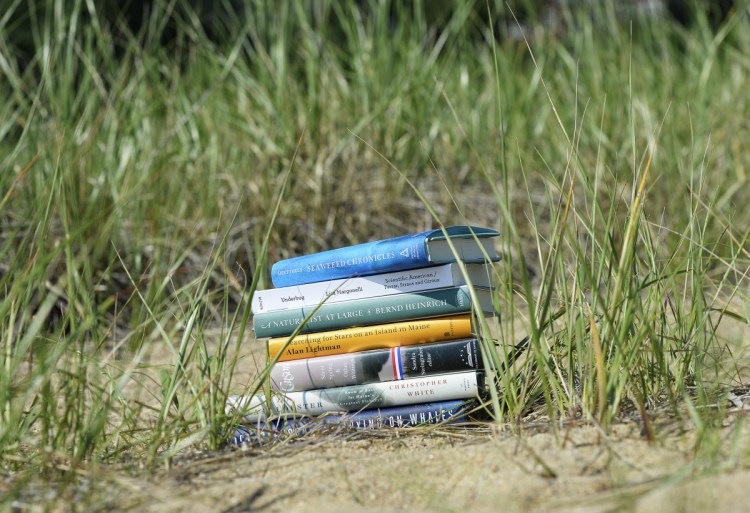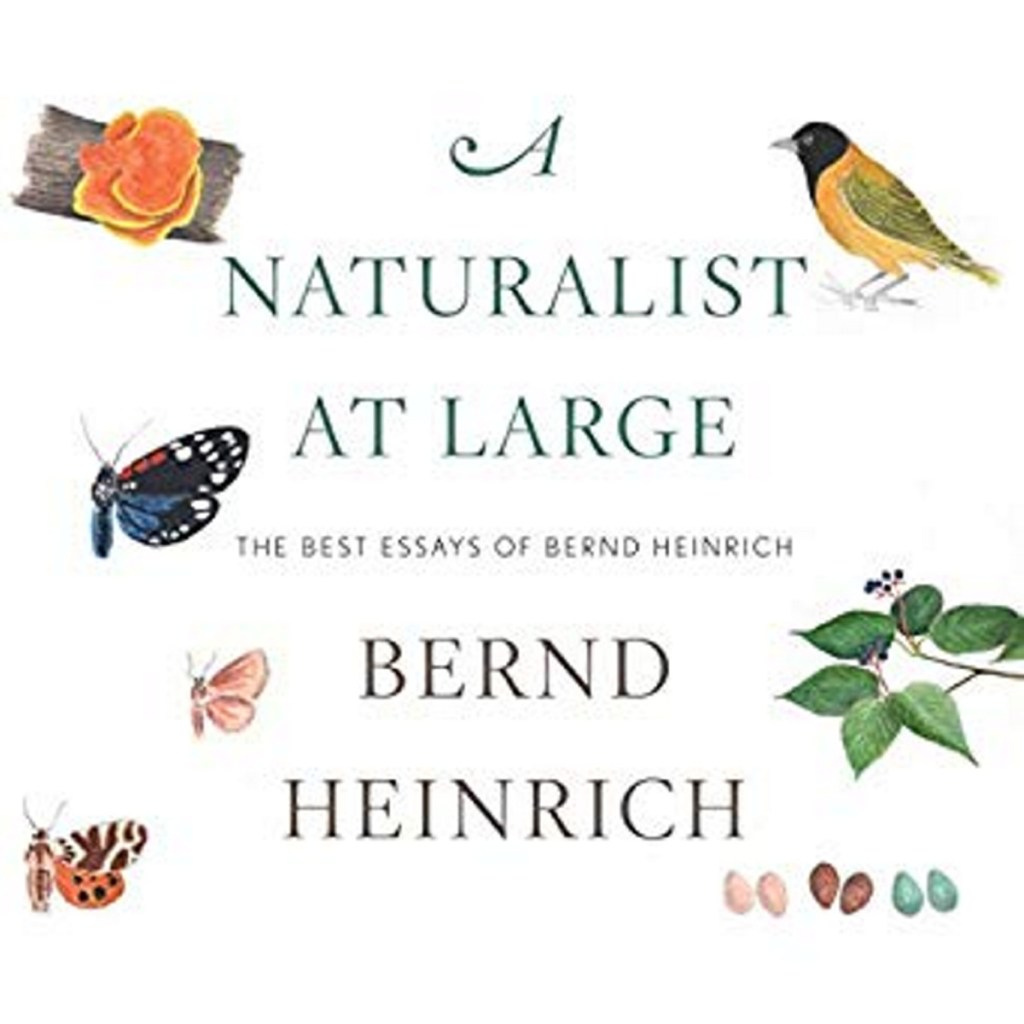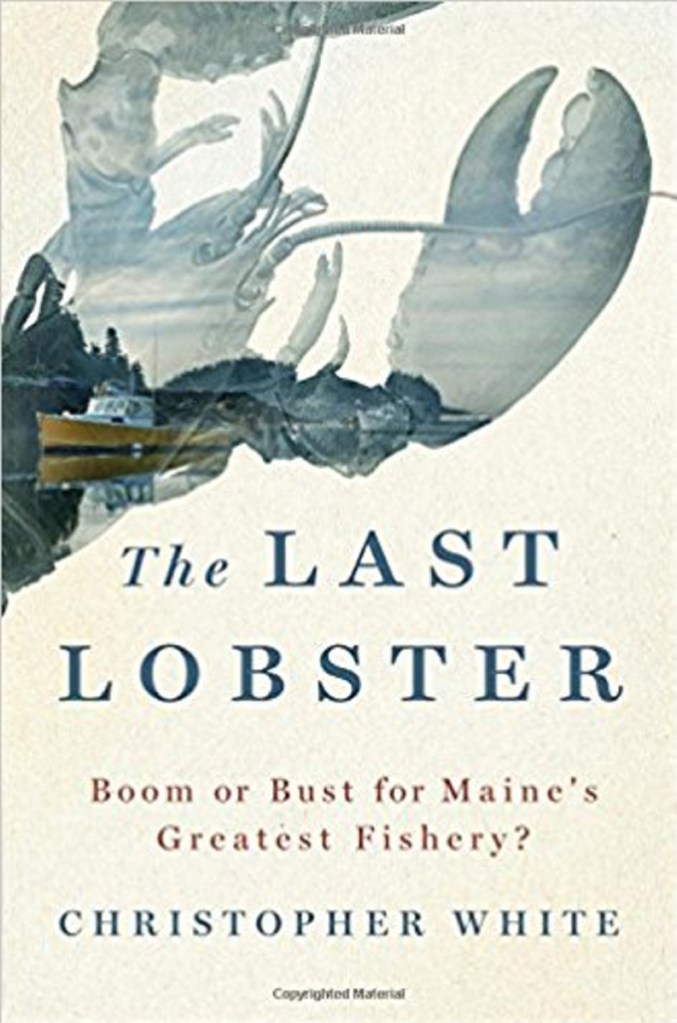We know it’s the season when we’re all allegedly longing to lie on the beach reading mindless books about people with minor problems and major love lives. But at Source, we’ve got a yen for feeding our minds in the summer – when we’re not pursuing the best soft-serve joints in the state – and this list speaks to that desire.
All of these books have some Maine connection, whether it be that the author lives here or the topic relates to the Pine Tree State. A few of these books have been out for months, and one of our favorites, “White Pine: American History and the Tree that Made a Nation” by Andrew Vietze, came out last fall but we neglected it then. Two won’t arrive in bookstores for a few weeks. Keep these titles in mind if you’re headed to that lake or state park or rental cottage and want to bring something with you that informs you on the real world we live in. We’ve listed them alphabetically by author, not in any ranking of quality.
“SILENT SPRING & OTHER WRITINGS ON THE ENVIRONMENT”
by Rachel Carson, with an introduction by Sandra Steingraber – The Library of America, March 2018, hardcover
The Library of America calls this a “deluxe” new edition of Carson’s seminal 1962 book about the harmful impacts of chemical pesticides. It’s an appropriate descriptor. The book includes the original “Silent Spring” and also a series of letters and essays showing how she pulled together the research for the book. Among them is a 1958 letter to E.B. White with some fan-undertones (“…I watch for, and devour, every word of yours that appears in The New Yorker”) but which is ultimately a press pitch, designed to get him to write about court hearings on DDT, as well as telling him about threats to the state they both loved from massive spraying for gypsy moths and fire ants. “I have been told that Maine is involved,” she writes. “I have several acres near Boothbay Harbor.”
The introduction by Sandra Steingraber, an environmentalist and author inspired by Carson, gives an excellent overview of her career. There’s a wonderful piece called “The Real World Around Us,” from a talk Carson gave in 1954, in which she details the response to her book “The Sea,” as well as a few rollicking accounts of her explorations of the natural world, from a fishing trip to the Georges Bank to a journey on a “glade buggy” in the Florida Everglades. She writes of that trip into the deepest swamp: “There is today the feeling that the land has formed only the thinnest veneer over this underlying platform of the ancient sea – that at any time the relations of sea and land might again be reversed.” Enough said.
“A NATURALIST AT LARGE: THE BEST ESSAYS OF BERND HEINRICH”
by Bernd Heinrich – Houghton Mifflin Harcourt, May 2018, hardcover
This collection contains essays written over the course of decades of Western Maine resident Bernd Heinrich’s life, including favorites on ravens and other birds, the American chestnut tree and the mysterious ways that an iris presents itself for pollination.
There’s a particularly magical essay on how Heinrich, as an 11-year-old boy in Maine (he’s 78 now) learned how to “bee-line” with a local Maine farmer named Floyd Adams to find a honey-filled hive. First they lure a bee with a piece of comb soaked in sugar syrup. She feeds, she leaves and they watch:
“We squinted to follow her flight, until she eventually disappeared into the distance in the direction where her hive would be. It could be in the nearest copse of woods or several miles away in some distant hollow tree in the depth of deep forest. We now had to narrow the possibilities of the hive location. Knowing the distance would help for a start, and that could be estimated from the bee’s travel time, as we expected her to return for another load of syrup. So we waited. Often in less than ten minutes a bee would suddenly be zigzagging at the edge of our bee box, and then settle into it to feed. A bee-line was now started, and soon more bees started coming. We dabbed white flour paste on the thorax or abdomen of some of them to time their flights. If the bee tree was close, our bee box would soon be crowded with bees, coming and going.”
There are many revelations here, not the least of which is the dawning of what and where that expression “make a beeline” comes from. Heinrich, now a full-time, off-the-grid Maine resident after many years of teaching at the University of Vermont, is one of the great naturalists of our time.
“SEARCHING FOR STARS ON AN ISLAND IN MAINE”
by Alan Lightman – Pantheon Books, March 2018, hardcover
The best-selling author (“Einstein’s Dreams”) and National Book Award finalist (“The Diagnosis”) writes an ode to his experiences as a part-time Maine resident. He has a house on a shared island in Casco Bay and in the course of an interview about light pollution in April said he arrives there every summer with the intent of spending as much time as possible right there, on that island.
He doesn’t name it in the book, because he wants to protect his neighbors’ privacy and that’s fine, because this could truly be any Maine island, with its woods and wildflowers and mosses and vistas of the water and the open sky. At night.
For Lightman, there is a night when he is motoring back to the island in the dark, navigating carefully, because as he says, he is not a “nautical person.” But the sky was vibrating with stars, and so he turns off the boat, lies on his back and looks up.
“After a few minutes, my world had dissolved into that star-littered sky. The boat disappeared. My body disappeared. And I found myself falling into infinity. A feeling came over me I’d not experienced before. Perhaps a sensation experienced by the ancients at Font-de-Gaume. I felt an overwhelming connection to the stars, as if I were part of them.”
The slim book is the story of what follows after he finds himself so merged with something so large it is a “hint of something absolute.” He examines the well-trod human searching for meaning – and the shape religion gives to it – through the eyes of a trained theoretical physicist – open to contradictions when it comes to absolutes. “I am a scientist,” he writes. “But I am not a swinging bob on a string.”
“UNDERBUG: AN OBSESSIVE TALE OF TERMITES AND TECHNOLOGY”
by Lisa Margonelli – Scientific American/Farrar, Straus and Giroux, August 2018, hardcover
When Maine native Lisa Margonelli took a “termite safari” in 2008 with a group of scientists from the U.S. Department of Energy’s Joint Genome Institute, she was already an expert on the problems of petroleum, having written about the subject for seven years (her book “Oil on the Brain: Petroleum’s Long, Strange Trip to Your Tank” came out in 2007). “I was at the end of my rope, both as an oil-consuming citizen and as a human being. Oil’s troubles are systemic, dating back at least a hundred years – and they’re made much nastier by modern politics.” The point of the termite safari was to acquire 10,000 termites for the scientists to study. Termites are famous for eating wood, and if they could eat wood, maybe they could help scientists trying to turn wood and grass into “grassoline.”
“If this trip succeeded in capturing a few good molecular moments, we humans might eventually be able to power our cars without worsening climate change, or make fuel without drilling in national parks or causing oil spills. This trip could change the world – or at least the lives of the scientists in the cars.”
It certainly changed Margonelli’s life. Termites, which she describes as “the architects of negative space” became her obsession. She would go on to learn an unholy amount about termites (here’s a statistic: they outweigh humans by 10 to 1. For every 132-pound person in the world, there are 1,320 pounds of termites). She would ultimately take three termite safaris, travel the world in pursuit of termite knowledge and eventually, move back to Maine, to a house on the Kennebec. (Side note: Margonelli serves on the shellfish committee in Arrowsic, which is working on clam aquaculture projects.) Twenty miles to the south of her, she writes, are termites, “steadily munching northward, year by year, as the Gulf of Maine warms.” This is a book about bugs, but really, it’s about our future.
“SPYING ON WHALES: THE PAST, PRESENT, AND FUTURE OF EARTH’S MOST AWESOME CREATURES”
by Nick Pyenson – Viking, June 2018, hardcover
Nick Pyenson is the curator of fossil marine mammals at the Smithsonian Institution’s National Museum of Natural History. He has been thinking about writing this book for years, he writes, while “doing science” all over the world and says he hopes it is as much about the inner lives of scientists as it is about whales.
We picked this out of the piles of books that come over the transom in part because of the plight of the right whales that live in the Gulf of Maine, threatened by entanglements with fishing gear, encounters with speeding ships and possibly, diminishing food supplies. Portland Press Herald reporter Colin Woodard has written extensively about right whales, which experts say could be extinct by 2040 (only 450 are left worldwide).
Right whales are mentioned, sporadically, but we quickly found a book of broader interest, something accessible we could hand off to a curious teenager without fear they’d drown in hard science. As Pyenson puts it, this book “is not a synoptic, comprehensive account of every different species of whale – there are far too many whales to fit into anything shorter than an encyclopedia. Instead, this book presents a selective account, a kind of travelogue to chasing whales, both living and extinct.” He describes experiences from the Antarctica, Chile, Panama, Iceland and Alaska and while he places the blame on the threat to whales worldwide clearly on man’s shoulders, he doesn’t paint an entirely dire picture. “Some whale species have rebounded from the brink, even expanding to new habitats as climate and oceans change,” he writes, and then dares the reader to imagine a shared future with whales. We’re in.
“SEAWEED CHRONICLES: A WORLD AT THE WATER’S EDGE”
by Susan Hand Shetterly – Algonquin Books of Chapel Hill, August 2018, hardcover
The Maine-based author has deep interest in wildlife and wetlands and has published two books for adults and six for children. In this measured, wise little book, she writes of the common Eider duck, the invasive green crab, the history of seaweed harvesting and in a chapter titled “The Uneasy Art of Making Policy,” considers concepts like “The Tragedy of the Commons” as applied to harvests of seaweed and other sea creatures. Here’s how she describes the book:
“This book is about seaweeds and seaweed harvesting. It is also a collection of stories about individual people who work and live at the shore and what they have shared with me of their lives. And it is about wildlife – fish, birds, snails and clams, the tiny scuds, and the big eagle throwing its dark shadow across the bay. They teach me about what’s worth saving.”
Shetterly’s style is in some cases, close to taking oral histories from her subjects, which include seaweed farmer Sarah Redmond and, in one of the most intriguing chapters, Linnette and Shep Erhart. The couple came to Maine in 1971, macrobiotic eaters who wanted to grow and harvest their own food, and ended up with Maine Coast Sea Vegetables, a business now worth $3.2 million. Shetterly spends a little time in the processing facility, joining the staff of five as they picked over dried dulse. She has a gift for description that takes us right there:
“The women all wore bandanas or hairnets, and we sat on stools, spreading the pungent, salt-laced purple dulse before us, snapping off an occasional holdfast, a few small periwinkles, tiny desiccated brine shrimp or mussels, an occasional infant green crab, and the ever-present epiphytes – smaller seaweed species that attach themselves to the growing dulse blades.”
“WHITE PINE: AMERICAN HISTORY AND THE TREE THAT MADE A NATION”
by Andrew Vietze – Globe Pequot Press, October 2017, paperback
Once upon a time, Andrew Vietze was the managing editor of Down East magazine. Today he is a Maine Guide who spends six months of the year as a ranger in Baxter State Park and has written 12 books, including one called “Becoming Teddy Roosevelt: How a Maine Guide Inspired America’s 26th President.”
His latest is a history of a tree that plays a vital role in Maine’s past, present and its future, the White Pine. But it’s really a history of human interaction with the East’s tallest trees, starting with Native Americans origin stories and a rollicking account of the little-known Pine Tree Riot in 1772. That was a precursor to the Boston Tea Party, in which New Hampshire colonists finally lost it with the British empire’s insistence that all the tallest pines belonged to the king (in this case, King George III) rather than the people who lived among them.
Vietze is a fluid and entertaining writer; this history lesson feels like anything but. This is the perfect book to read in August while sitting on a deck in the Maine woods (with your citronella candle going, of course), surrounded by white pines. Or better yet, head into Baxter State Park with this in your backpack; you might just bump into the author.
“THE LAST LOBSTER: BOOM OR BUST FOR MAINE’S GREATEST FISHERY?”
by Christopher White – St. Martin’s Press, June 2018, hardcover
Christopher White spent several years getting to know a few Maine lobster boat captains. He moved to Stonington and even crewed on some of the boats. His intention was to see, at a ground level, how warming waters – and climate change – are having an impact on Maine’s most significant fishery. (Even with landings down 15 percent last year, Maine lobstermen and women still pulled in 111 million pounds of the crustaceans last year.)
His narrative takes a newcomer’s perspective, nosing around the state a bit to explain how the heart of the fishery has shifted northward from Portland, before eventually settling on Stonington as the epicenter of the story. Some Maine readers might find White’s approach a little too gee-whiz-Lobster-101, but whatever his approach, it gains him entry. One day he’s on a boat watching the traps get hauled, the next he’s sitting down to dinner in Stonington at the Fisherman’s Friend (since newly remodeled and named Stonecutter’s Kitchen) with a lobsterboat captain and former secretary/treasurer from the Maine Lobstering Union at his side and a lobsterman/chef inviting him into the kitchen to see how lobster gets turned into restaurant dishes, 16 different ways, and marked up fourfold from the price at the dock.
And he shows up in winter, heading out with lobsterboat captain Frank Gotwals, who talks sales to China and the ins and outs of resource management in the lobster fishery. And explains, rather beautifully, the lobstering philosophy:
Lobstermen are generally averse to joining any faction that limits their catch or does them any other favors.
To illustrate this point, Frank offers a joke. “Two lobstermen are making their way in a thick fog, without compass or radar. They seem to be lost. Older man says to younger, ‘Do you know any prayers?’ ‘Yes.’ ‘Start praying.’ The younger man chants feverishly. The old-timer says, ‘Not too much, we don’t want to be beholden.’ “
Send questions/comments to the editors.






Success. Please wait for the page to reload. If the page does not reload within 5 seconds, please refresh the page.
Enter your email and password to access comments.
Hi, to comment on stories you must . This profile is in addition to your subscription and website login.
Already have a commenting profile? .
Invalid username/password.
Please check your email to confirm and complete your registration.
Only subscribers are eligible to post comments. Please subscribe or login first for digital access. Here’s why.
Use the form below to reset your password. When you've submitted your account email, we will send an email with a reset code.